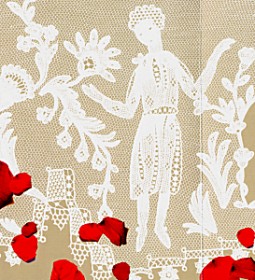| |
The
creative focus of this exhibition is the wedding feast. On the ground floor, musicians receive the
party. The festively laid table is ready for the banquet.
This is where today's wedding dresses are presented. If
you like, you may select a dress to try on.
Wedding photographs, wedding garments
and wedding stories from the people of St.Gallen
accompany visitors on their way to the second floor.
In this hall, too, a festive table awaits them, around
which a wealth of bridal gowns demonstrate their
development in terms of history and fashion. Textiles in
showcases elucidate
the themes of love, marriage tokens, trousseaux and
weddings.
Lavish costume design
The pomp and circumstance
surrounding weddings has been considerable from time
immemorial. Very early on, townships decreed rules to
limit festivities, the amount of the dowry, presents and
– to no one's surprise – the garments worn by
brides.
Representations and written records of bridal gowns only
started in the 15th century. There was a great diversity
of wedding garments. The bride wore her best dress, with
a bridal wreath indicating her status as a bride. From
the 17th century onward, France determined Europe's
cultural life, and brides now dressed in the French
fashion.
The white wedding dress – a
tradition that is still only recent
Records refer to white wedding
dresses earlier than the 19th century; however, there is
no evidence of how widespread white weddings were. The
precursors of the white bridal gowns are likely to have
been the white diaphanous garments that were in fashion
about 1800. In 1826, the Petit Courrier des Dames
presented a white wedding dress for the first time. The
first princess to wear a white dress was the English
Princess Victoria at her wedding to Prince Albert of
Saxe-Gotha in 1840. Princess Elizabeth of Bavaria still
remains the most beautiful bride of the 19th century. At
her wedding to Emperor Franz Joseph I. in 1854, Sisi wore
a dress of pure white duchesse silk. Until the late 19th
century, white wedding dresses were the prerogative of
rich daughters. Other brides got married wearing a white
veil and a black dress, which remained their best dress
after the wedding. It was only in the early 20th century
that the white wedding dress established itself, and it
was soon regarded as traditional. Even today, a white
wedding stands for all the dreams of love, and it is a
symbol of romanticism and happiness. The conventional
wedding dress combines elements of the 19th century
bridal gown, namely a closely fitting bodice, tapering at
the waist, and with a long white skirt. In rural areas,
about 60% of all the brides still walk up the aisle in
these charming and romantic bridal dresses. Quite soon,
however, only a third of all brides will be likely to opt
for a traditional dress.
The world's most beautiful people
Up to the millennium, the bride
was a princess for a day; the wedding day was her day,
and the bridegroom, in a black suit, remained discreetly
in the background. Today, this would appear to be
changing. For the modern bridal pair, love is the only
reason for marriage. This is why it is no longer the
bride alone who occupies centre-stage on her wedding day;
the bridegroom, too, wants to be the world's most
handsome man.
Ursula Karbacher, lic. phil. , curator
|

